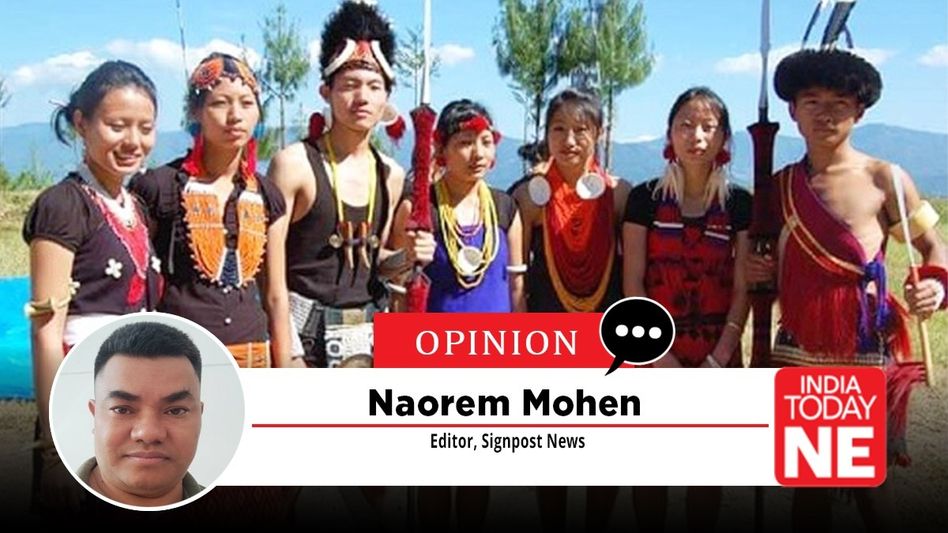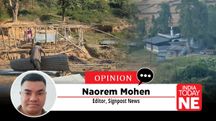From Manipur to Nagaland: Kuki Tribes and the Rise of Indigenous Protectionism
The escalating ethnic tensions in Manipur, particularly surrounding the Kuki tribes' contested status within the Scheduled Tribe (ST) framework, have reverberated across Northeast India, igniting a wave of indigenous protectionism in Nagaland.

The escalating ethnic tensions in Manipur, particularly surrounding the Kuki tribes' contested status within the Scheduled Tribe (ST) framework, have reverberated across Northeast India, igniting a wave of indigenous protectionism in Nagaland.
In Manipur, the push to exclude "Any Kuki Tribes" from ST benefits, fueled by groups like the Thadou Inpi Manipur and Meitei Alliance post-2023 violence, has set a precedent for exclusionary policies.
This trend is mirrored in Nagaland, where stalled police recruitment for non-Naga tribes like Kukis and stringent indigenous verification processes reflect a broader regional drive to prioritize local identities, raising critical questions about equity and constitutional safeguards.
Manipur state's push to exclude Kuki tribes from the Scheduled Tribe (ST) quota, the Any Kuki Tribes Council’s (AKTC) complaints over ST certificate denials, and the Federation of Haomee’s (FoH) "Indigenous Pillar" initiative asserting original people of the state. The ongoing Nagaland state enumeration, certificate denials to Any Kuki Tribes in Manipur, and FoH’s Indigenous pillar-driven assertions highlight unilateral flaws.
In Nagaland, the paused recruitment of police constables for posts reserved for four non-Naga tribes—Garos, Kacharis, Mikirs (Karbis), and Kukis—reflects this trend, driven by a stalled enumeration exercise to verify indigenous status, leaving 24 reserved posts on hold as of October 2025. A recent Naga Students’ Federation (NSF) objection to a non-indigenous candidate’s NEET 2025 state quota eligibility further highlights Nagaland’s gatekeeping.
Extending this lens to Mizoram, Assam, Arunachal Pradesh, Meghalaya, and Sikkim reveals a regional pattern: policies prioritizing "indigenous" or domiciled populations, often marginalizing non-indigenous or minority groups, fueling debates over equity and constitutional safeguards.
Also Read: Why was the Governor absent from Manipur's state-level Mera Hou Chongba Festival
In Nagaland, the Constitution (Nagaland) Scheduled Tribes Order, 1970, recognizes Garos, Kacharis, Mikirs (Karbis), and Kukis as STs, provided they were residents before December 1, 1963. This cut-off entitles pre-1963 settlers and their descendants to ST certificates and Indigenous Inhabitant Certificates (IICs), unlocking government jobs and educational quotas.
On October 7, 2025, the Nagaland Home Department announced that recruitment for 24 police constable posts reserved for these tribes is deferred pending a September 2024 enumeration exercise to verify indigenous status, addressing concerns over post-1963 migrations from Assam, Meghalaya, and Manipur.
The government aims to curb fraudulent certificate issuance, but the process faces backlash. Tribal bodies representing the four non-Naga tribes secured a Gauhati High Court stay, extended in June 2025, keeping the matter sub judice.
Meanwhile, recruitment for 1,176 posts for Naga tribes proceeds, fueling perceptions of exclusion.The Association of Indigenous Minority Tribes of Nagaland (AIMTN) decried the exclusion of these tribes in the September 30, 2025, police recruitment notification, citing the Home Department’s July 6, 1973, order mandating 100% reservation for non-technical Grade III & IV posts and 80% for other direct recruitment posts for indigenous inhabitants.
In August 2025, the Naga Students’ Federation (NSF) objected to Vatsala Panghal’s NEET 2025 State Quota candidature, alleging she is ineligible as a Haryana native, despite her Kohima address tied to her father’s posting as Commanding Officer of 1 Nagaland NB, NCC. Scoring 455 marks with an All India Rank of 113803, Panghal topped Category III, but NSF President Medovi Rhi and Education Secretary Temjentoshi argued that state quotas are reserved for Nagas by blood and indigenous inhabitants, per constitutional safeguards.
These patterns mirrors exclusionary rhetoric in Manipur, highlighting Nagaland’s sensitivity to non-indigenous access. Nagaland’s 2011 Census shows 1.98 million people, with Nagas over 85% and non-Naga STs at 5-7%. The 2019 Register of Indigenous Inhabitants of Nagaland (RIIN) Commission flagged certificate irregularities, but the enumeration’s reliance on oral histories and sparse records raises fairness concerns.
The Sikkim Government Services (Reservation for Local Persons) Rules, 2023, mandate 100% job reservations for holders of the Certificate of Identification (COI) or Sikkim Subject Certificate (SSC), issued only to those with pre-1975 domicile or descent from Sikkim Subjects listed in 1961. This excludes non-indigenous STs, such as Nepali-origin groups (despite their 60% population share), unless they hold COI/SSC.
With a 94% ST population, Mizoram’s 2021 amendment to the Selection of Candidates for Higher Technical Courses Rules allocates 93% of ST seats to Zo-ethnic Mizos, 1% to non-Zo STs (Chakmas, Hmars, Brus), and 4% open. Challenged by groups like the Mizoram Chakma Students’ Union, this policy, affecting jobs and education, faces Supreme Court scrutiny post-2024 sub-categorization rulings, as non-Zo STs argue it undermines their constitutional rights.
Facing migration pressures (STs at 12.4%), Assam’s 2025 domicile policy restricts jobs to those born in the state, prioritizing indigenous Assamese. Alongside 7% SC, 15% ST, 27% OBC, and a 3% tea tribe/Adivasi quota (August 2024), sub-quotas for Morans and Mataks emphasize indigeneity, potentially excluding ST migrants like Kukis or Garos, amid NRC-related tensions.
With 68% STs (Adi, Nyishi, etc.), Arunachal enforces 80% job/education reservations for Arunachal Pradesh Scheduled Tribe (APST) certificate holders, requiring pre-1987 indigenous descent proof via village councils and genealogies. The 2021-2023 ST list refinements addressed “indicative” categories like “Any Naga Tribes,” but the Arunachal Indigenous Tribal Forum’s 2025 enumeration push risks excluding mixed-heritage or migrant STs, echoing Nagaland’s RIIN.
The 1972 State Reservation Policy allocates 80% ST quota (40% Khasi-Jaintia, 40% Garo, 5% minor tribes, 15% unreserved), despite Khasi-Jaintia (48%) outnumbering Garos (31%). Khasi groups like the Khasi Students’ Union (KSU) demand 50% for Khasi-Jaintia in 2024-2025 submissions to the Expert Committee, while Garos and minor tribes (Rabha, Hajong) protest via the Meghalaya Indigenous Minority Scheduled Tribe Forum, citing constitutional protections. The 2023-2024 roster system favoring Garos sparked bifurcation threats, mirroring Manipur’s ethnic rifts.
Manipur’s ethnic volatility, fuels its 31% ST quota conflict. CSOs like the Thadou Inpi Manipur and Meitei Alliance demand the removal of “Any Kuki Tribes” (AKT) from the ST list, added in 2003, citing its broad scope and alleged Myanmar migrant inclusion. The Thadou groups urged halting certificate issuance.On October 7, 2025, AKTC Chairman Ngamlal Doungel appealed to Governor Ajay Kumar Bhalla, decrying district administrations’ refusal to issue ST certificates to AKT members, recognized under the Constitution (Scheduled Tribes) Order, 1951, and the 2002 Amendment Act.
The denial of ST Certificate to Any Kuki Tribes stems from scrutiny post-2023 ethnic violence. The Federation of Haomee (FoH), has escalated this narrative through its "Indigenous Pillar" initiative. Coincidently, this week, the FoH erected stone pillars in Imphal East of Manipur to assert 25 tribes are the only indigenous groups countering "external challenges" like Kuki land claims.
These threads—Nagaland’s enumeration, Manipur’s AKT exclusion, Mizoram’s Zo-centric quotas, Assam’s domicile rules, Arunachal’s APST verification, Meghalaya’s inter-tribal quota disputes, and Sikkim’s COI/SSC restrictions—reflect a regional drive to protect indigenous entitlements amid migration fears. Cross-border tribes like Kukis and Garos face scrutiny in Nagaland and Manipur, minimal quotas in Mizoram, domicile barriers in Assam, APST hurdles in Arunachal, minor tribe exclusion in Meghalaya, and COI denials in Sikkim. Manipur’s 2018 and 2023 cabinet moves to delete AKT, opposed by AKTC’s constitutional claims, mirror Sikkim’s COI gatekeeping, which excludes Nepali STs despite their demographic weight.
This exclusionary model, rooted in Manipur violence and displacement, inspires Mizoram’s Zo-centric quotas, Assam’s domicile rules, Arunachal Pradesh's APST scrutiny, Meghalaya’s tribal quota battles, and Sikkim’s COI gatekeeping. While safeguarding indigenous rights counters historical marginalization, rigid exclusion risks alienating contributors—like Panghal in Nagaland or Nepali STs in Sikkim—deepening ethnic fault lines.
The Northeast urgently needs verification exercises like Nagaland’s RIIN and Manipur’s AKT scrutiny to protect indigenous interests, ensuring resources like jobs, education, and land rights prioritize those with deep-rooted ties to the region. In Nagaland, the government’s stance on verifying pre-1963 settlers for IICs and benefits is critical to prevent fraudulent claims, maintaining the integrity of reservations outlined in the 1973 order.
Similarly, in Manipur, halting the misuse of dual benefits—where individuals claim ST quotas from their respective tribes and the overly broad AKT category—is essential to safeguard Meitei and Naga entitlements. The flame of Manipur’s conflict, fueled by FoH’s Indigenous Pillars, has awakened neighboring states to the dangers of unchecked policies that marginalize indigenous groups. Nagaland’s NSF action, Mizoram’s Zo-centric quotas, and Assam’s domicile rules reflect this awakening, but they must adhere to state policies that prioritize indigenous communities while ensuring transparent, inclusive verification to balance constitutional equity with regional realities.
Thus, the ripple effects of Manipur crisis, particularly the exclusion of Kuki tribes from ST benefits, have catalyzed a broader wave of indigenous protectionism across Northeast India, with Nagaland’s stringent verification processes and reservation policies serving as a stark example. These measures aim to safeguard indigenous rights and curb fraudulent claims.
Copyright©2025 Living Media India Limited. For reprint rights: Syndications Today









